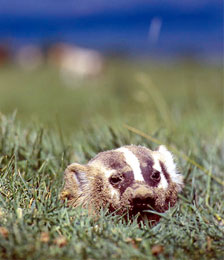page4
Ensuring badgers remain a vital part of the East Kootenays is the aim of an international, public-private sector partnership
Local landowners and Kootenay National Park of Canada help conserve the endangered badger as well as rare grassland habitat
Four subspecies of American badger occur in North America. In Canada, the endangered Taxidea taxus jeffersonii lives only in British Columbia's dry interior, such as the Columbia Valley at the southern end of Kootenay National Park. Despite having few natural predators, British Columbia badger numbers are in decline because of loss of habitat, a decrease in prey species, and death caused directly by human activities. There are fewer than 350 remaining adults.
Badgers live in grasslands, shrub-steppe habitats or open-canopied forests of Ponderosa pine or Douglas fir that supply the right soil for burrowing and enough small mammals to prey on. The only carnivore that burrows after and eats other tunnelling animals, the badger is a key predator of ground squirrels, mice and voles. Badgers play an important role in grasslands ecosystems. When badgers dig to pursue prey or to excavate a burrow, they improve soil conditions for various plants. In addition, their large burrows provide shelter for other wildlife, such as Burrowing owls and snakes.
Initiated in 1995 with the participation of Parks Canada, the East Kootenay Badger Reintroduction and Threat Mitigation Project is a collective effort to improve and restore badger populations in the region. The project, supported by the Species at Risk Recovery Fund, includes Canada's first intensive radio telemetry-based long-term study of badger ecology and distribution. For the research phase of the project, badgers are live-trapped and implanted with a radio transmitter. They are then returned to their burrows and can be tracked using a radio-telemetry receiver. Researchers assess badger population trends, habitat needs and the effects of human activities.
 Badger lying in the grass © Tim McAllister |
Since 2002, in cooperation with United States-based researchers, 16 badgers have been moved (or translocated) from northwestern Montana to the East Kootenays' upper Columbia Valley to "kick-start" the recovery phase of the Columbia Valley badger population. Research has shown that the key to conserving these animals is stewardship on private land. Along with their many partners, Parks Canada staff, summer students and volunteers are working with the public to promote practices that will protect the badger and its habitat within and across park boundaries.
Results
- The project is Canada's first intensive radio telemetry-based study of badger ecology and distribution.
- Thirty-two badgers from Radium Hot Springs to Cranbrook have been implanted with radio transmitters to determine: movement rates and home range size; patterns of habitat use and dispersal; birth rates and reproductive success; and causes of death.
- Of the 16 badgers translocated from Montana to the south end of the East Kootenays, all three translocated females successfully reproduced in 2004, adding eight kits to the population.
- Radio-tagged badgers have been shown to use culverts to cross highways. Parks Canada and the British Columbia Ministry of Transportation built the first badger tunnel in the province. Badger crossing signs were installed elsewhere to encourage drivers to slow down in badger habitat.
- Project biologists work closely with golf course managers, highway designers, private landowners and conservation organizations to encourage stewardship practices for the recovery of badgers and their prey, ground squirrels.
 Badger-crossing sign by the road © Richard Klafki |
- Date modified :